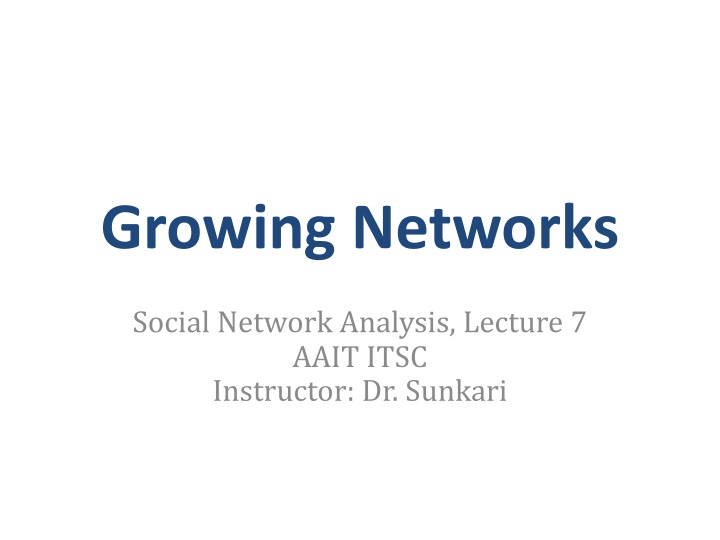
Analyzing Growing Random Networks in Social Network Analysis Lecture
Explore the concepts of growing random networks in social network analysis lecture, covering topics such as preferential attachment, assortativity, clustering, and properties of real networks. Dive into the dynamics of forming new links, triadic closure, and preferential attachment in network growth models.
Download Presentation

Please find below an Image/Link to download the presentation.
The content on the website is provided AS IS for your information and personal use only. It may not be sold, licensed, or shared on other websites without obtaining consent from the author. If you encounter any issues during the download, it is possible that the publisher has removed the file from their server.
You are allowed to download the files provided on this website for personal or commercial use, subject to the condition that they are used lawfully. All files are the property of their respective owners.
The content on the website is provided AS IS for your information and personal use only. It may not be sold, licensed, or shared on other websites without obtaining consent from the author.
E N D
Presentation Transcript
Growing Networks Social Network Analysis, Lecture 7 AAIT ITSC Instructor: Dr. Sunkari
Outline Before: Networks as graphs, Graph theory, Random graphs, Homophily Temporal analysis necessary Today: Growing random networks, exhibit life-like characteristics? Preferential attachment Assortativity and degree correlation Clustering
Background: New links over time Triadic closure: person => person:person Focal closure: focus => person:person Membership closure: person => focus:person Social-Affiliation Graph
What about new nodes? Pre-existing network: m connected nodes At birth : Index node s birth order = i Node i gets di(i) links at random Later, at time t: # New links = di(t) - di(i)
Properties of real networks In a growing random network model Express realistic properties? 1. Nodes aren t equally likely to link 2. Low diameters 3. High Clustering
GROUP DISCUSSION: For a new node i,how would you pick nodes that i should link to at birth?
Preferential Attachment (Barabasi & Albert 1999) Idea: Nodes of high degree are more likely to form new links Ex: Well-cited scientific papers more likely to be read & cited {long,fat,heavy}-tail/scale-free distr. (Price 1976) A few rich get richer Long tail of poor Image credit: Pender, Casey. The Long-tailed Network Structure of Trade. In Blog: PPE.life. 2017. Blog: http://ppe.life/long-tailed-trade/.
Pref. attachment on a Graph New node is born ; link to node i? ( = i t P to links at node new ( ) d 1 probability is proportionate to node degree d t ) i m ( ) t = t j j new node will make m connections ( ) t 2 di t total # links * 2 (At time t: = 2 tm) = Expected degree of i: (Using the mean-field approximation) Freq. distr. of degree: / 1 2 t ( ) t = di m i ( ) d = 2 3 2 ft m d
What pref. attachment gets you Long-tail degree distribution Older nodes have highest degrees Not always precise in practice (e.g., article citations) Hybrid models: random uniform + pref. attach.
Diameter in pref. attachment Proposition: In a preferential attachment model where each newborn node forms m 2 links, as n grows the resulting network will consist of a single component with diameter proportional to log(n)/(log log(n)), almost surely. Poisson: proportional to log( Poisson: proportional to log(n n). ). Pref. attach: lower diameter Pref. attach: lower diameter (Bollobas & Riordan 2002)
GROUP DISCUSSION Do you expect a node to connect to other nodes that have a similar node degree, or different? (e.g., high degree nodes connect with other high degree nodes) Real networks: SIMILAR! Real networks: SIMILAR! Assortativity Assortativity
Prob that i has degree d is at least as high (and at least once higher) than j Assortativity Nodes and their neighbors degrees are positively correlated Proposition: On average A. Node i s degree is larger than node j s degree at time tafter both are born if and only if i is older than j. B. In that case, the estimated distribution of i s neighbors degrees strictly first order stochastically dominates that of j s at each time t > j, and in particular for all d < di(t).
Simple process clustering New node chooses to link to node j (prob p) Next: Follow from node j to another node with prob q Or jump to new node with prob 1-q
GROUP DISCUSSION: New node chooses to link to node j (prob p) Next: Follow from node j to another node with prob q Or jump to new node with prob 1-q What happens if q=0? If q=1?
